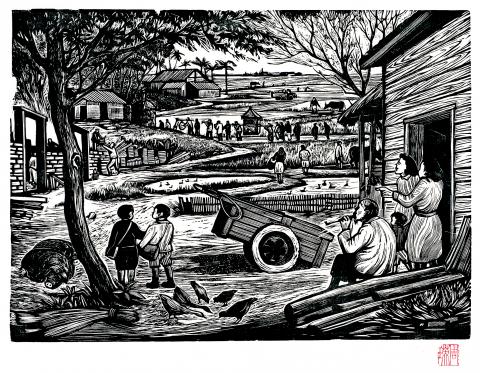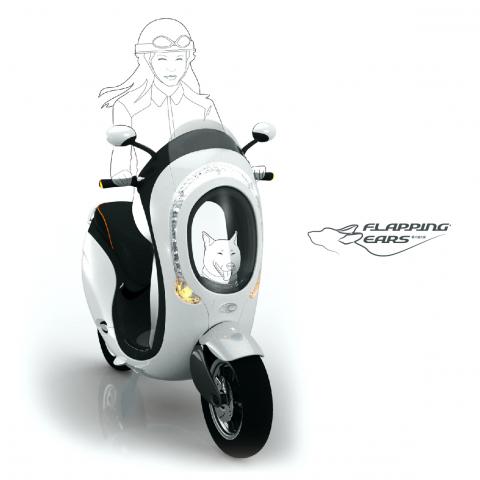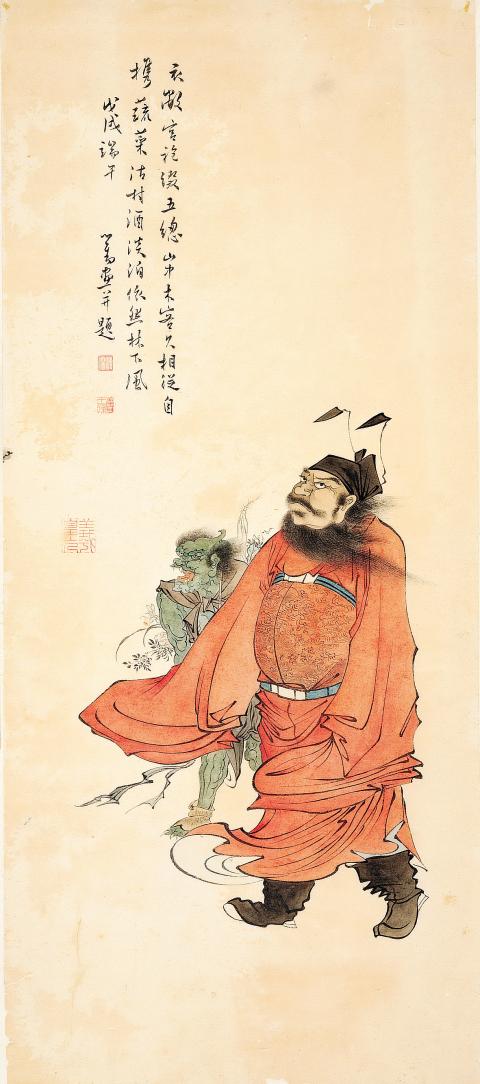The 32nd Young Designers’ Exhibition (YODEX, 新一代設計展) opens today with original fashion, art and advertising, industrial, digital media and interior designs by local students. YODEX, which serves as a recruitment platform, is built around a juried competition. Among the 59 contenders is National Taipei University of Technology’s Department of Industrial Design, whose entries include an office chair that pulls out so you can nap face-down, and Flapping Ears (愛犬電動速克達), a contoured scooter that gives your pet a comfortable ride and a great view. Tatung University, another exhibitor with a strong record, has toys like the Walkabout, a mobile-phone powered device that’s pushed out from the waterfront to pick up trash a swimmer can’t reach.
■ Taipei World Trade Center Hall 1 and Hall 3, 5, Xinyi Rd Sec 5 (北市信義路五段5號) and 6 Songshou Rd (松壽路六號); tel: (02) 2745-8199 ext. 581. General admission: NT$200
■ Until Monday

Photo courtesy of KdMoFA
Chinese painter Su Xioabai (蘇笑柏) manages conflict with a light touch at Grand Immensity — the Art of Xiaobai Su (大境-蘇笑柏藝術展), his painting and installation exhibition at Taichung’s National Taiwan Museum of Fine Arts in Taichung (國立台灣美術館). Su, who trained at Germany’s prestigious Dusseldorf Academy of Fine Arts, has developed a visual language that blends Occidental and Chinese aesthetics. He treats the canvas with big shimmery blocks of color like the western expressionists do, but applies classic Eastern iconography and Chinese mediums like lacquer to give his paintings a peculiar luster. Su eschews the symbols of nation, preferring to let his works surpass difference.
■ National Taiwan Museum of Fine Arts in Taichung (國立台灣美術館), 2, Wuquan W Rd Sec 1, Greater Taichung (台中市五權西路一段2號), tel: (04) 2372-3552. Open Tuesdays to Sundays from 9am to 5pm
■ Until July 21

Photo courtesy of National Taipei University of Technology
The National Museum of History is showing 203 paintings and calligraphy works of artist Pu Xinyu (溥心畬), 50 years after his death. Pu, cousin to China’s last emperor Pu Yi (溥儀), won acclaim during the Qing Dynasty for perfecting the trifecta of Chinese arts: poetry, calligraphy and painting. After fleeing to Taiwan in the same year as Chiang Kai-shek (蔣介石), Pu taught at National Taiwan Normal University and continued his work at a studio in Taipei until his death in 1963. The Scholar-Recluse: Painting and Calligraphy by Pu Xinyu (逸筆儒風:溥心畬書畫展) includes calligraphy — Pu excelled at running and clerical script — and classical paintings of nearly every genre: landscapes, birds-and-flowers and subject paintings featuring the mythological Zhong Kuo (鍾馗), an exorcist who wards off demons during the Dragon Boat Festival.
■ National Museum of History (國立歷史博物館), 49 Nanhai Rd, Taipei City (台北市南海路49號), tel: (02) 2361-0270. Open Tuesdays to Sundays from 10am to 6pm. General admission: NT$30
■ Until June 23

Photo courtesy of the National Museum of History
An Ode to Printmaking: A Retrospective (周瑛印紀) surveys the late printmaker Chou Ying (周瑛), who cofounded the Taiwan Society of Printmaking in 1970. Chou began his career with classic woodcut prints that rendered country folk in refined and realistic lines. After 1950, he branched out into other mediums such as cane-fiber boards, paper and finally stone. Chou’s Ode to Stone, a series on display at the Kuandu Museum of Fine Arts (KdMoFA, 關渡美術館), was created by an innovative rubbing — not carving — technique that makes the cold stones exude warmth and light on prints.
Kuandu, a nine-gallery museum, is also showing works by contemporary artist Hsieh Li-fa (謝里法). Hsieh is a main driver of Taiwan’s postwar art scene, and has worked primarily in art criticism and oil painting. In his early years, he was also a prolific printmaker. Old Plates New Prints — A Solo Exhibition by Hsieh Lifa (舊版新印-謝里法版畫作品展) presents a decade of his early printing work, dating from school days in Paris to his New York City apprenticeship in 1974. The prints are linocuts and zincographs that remark on and sometimes deconstruct local art trends, as well as document Hsieh’s own evolution as an artist.
■ Kuandu Museum of Fine Arts (KdMoFA, 關渡美術館), 1 Xueyuan Rd, Taipei City (台北市學園路1號), tel: (02) 2896-1000 ext 2432. Open Tuesdays to Sundays from 10am to 5pm
■ Until July 14
Sixty-one galleries from Taiwan, Japan, Singapore and China bring contemporary pieces to the fifth annual Young Art Taipei 2013, a fair that shows artists under the age of 45.
■ Sheraton Taipei Hotel, F9, 12, Zhongxiao E Rd Sec 1, Zhongzheng Dist, Taipei City (台北市忠孝東路一段12號守九樓). Open today from 2pm to 10pm, tomorrow and Sunday from 12pm to 8pm. Admission: NT$250
■ Opening reception today at 8pm. Until Sunday

On April 26, The Lancet published a letter from two doctors at Taichung-based China Medical University Hospital (CMUH) warning that “Taiwan’s Health Care System is on the Brink of Collapse.” The authors said that “Years of policy inaction and mismanagement of resources have led to the National Health Insurance system operating under unsustainable conditions.” The pushback was immediate. Errors in the paper were quickly identified and publicized, to discredit the authors (the hospital apologized). CNA reported that CMUH said the letter described Taiwan in 2021 as having 62 nurses per 10,000 people, when the correct number was 78 nurses per 10,000

As we live longer, our risk of cognitive impairment is increasing. How can we delay the onset of symptoms? Do we have to give up every indulgence or can small changes make a difference? We asked neurologists for tips on how to keep our brains healthy for life. TAKE CARE OF YOUR HEALTH “All of the sensible things that apply to bodily health apply to brain health,” says Suzanne O’Sullivan, a consultant in neurology at the National Hospital for Neurology and Neurosurgery in London, and the author of The Age of Diagnosis. “When you’re 20, you can get away with absolute

May 5 to May 11 What started out as friction between Taiwanese students at Taichung First High School and a Japanese head cook escalated dramatically over the first two weeks of May 1927. It began on April 30 when the cook’s wife knew that lotus starch used in that night’s dinner had rat feces in it, but failed to inform staff until the meal was already prepared. The students believed that her silence was intentional, and filed a complaint. The school’s Japanese administrators sided with the cook’s family, dismissing the students as troublemakers and clamping down on their freedoms — with

As Donald Trump’s executive order in March led to the shuttering of Voice of America (VOA) — the global broadcaster whose roots date back to the fight against Nazi propaganda — he quickly attracted support from figures not used to aligning themselves with any US administration. Trump had ordered the US Agency for Global Media, the federal agency that funds VOA and other groups promoting independent journalism overseas, to be “eliminated to the maximum extent consistent with applicable law.” The decision suddenly halted programming in 49 languages to more than 425 million people. In Moscow, Margarita Simonyan, the hardline editor-in-chief of the